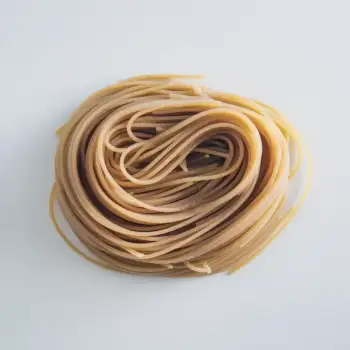Linguine and Fettuccine are two types of pasta with distinct shapes and traditional sauce pairings, with linguine being narrower and often served with seafood or pesto, while fettuccine is wider, suited for hearty, creamy, or meaty sauces.

Linguine is a type of pasta similar to fettuccine but elliptical in section rather than flat. It is about 4 millimeters in width, which is wider than spaghetti but not as wide as fettuccine. Traditionally, linguine is served with seafood or pesto.

Fettuccine is a flat thick pasta made of egg and flour, approximately 6.5 millimeters wide. It's popular in Roman and Tuscan cuisine, and its robust texture makes it well-suited for hearty sauces and ragus.
The main differences between linguine and fettuccine are their shape and the sauces they are traditionally paired with. Linguine's narrower, elliptical shape pairs well with lighter, more delicate sauces, often seafood-based. In contrast, fettuccine's wider, flat shape makes it ideal for thicker, heavier sauces, such as Alfredo or Bolognese.

Your ultimate Recipe Box, Meal Planner, and Cooking Class all in one
Linguine is traditionally used in seafood dishes like Linguine alle Vongole (with clams) where its shape complements the light seafood sauces. The pasta's surface area captures the sauce without overwhelming the delicate seafood flavors. Fettuccine is famously served with rich cream-based sauces such as Fettuccine Alfredo. The wide, flat noodles provide an ample surface for the creamy sauce to cling to, ensuring a perfect balance of pasta and sauce with every bite. Linguine pairs excellently with pesto sauces, as the grooves in the pasta help to trap the sauce, allowing the flavors of basil, garlic, and cheese to shine through in dishes like Linguine al Pesto. Fettuccine's sturdiness makes it ideal for heavier meat sauces like ragu. The pasta holds up to the density and richness of the sauce in dishes like Fettuccine alla Bolognese.
The nutritional values of linguine and fettuccine are quite similar, especially if they are made from the same ingredients. However, fresh fettuccine made with eggs may have a higher calorie and fat content.
| Nutrient | Linguine ( per 100 grams ) | Fettuccine ( per 100 grams ) |
|---|---|---|
| Fat | 1.5g | 1.7g |
| Fiber | 2.7g | 2.9g |
| Sodium | 6mg | 7mg |
| Protein | 13.3g | 14.0g |
| Calories | 371 | 371 |
| Carbohydrates | 73.9g | 74.0g |
While you can substitute linguine for fettuccine, the dish may not have the traditional texture and sauce-to-pasta ratio that fettuccine Alfredo is known for.
Linguine is often preferred with pesto as its shape holds the sauce well, allowing the flavors of the pesto to be more pronounced.
Both linguine and fettuccine should be cooked in a large pot of salted boiling water until al dente, which means they are cooked through but still have a slight bite to them.
They can be substituted for each other, but keep in mind that the texture and sauce adherence will vary due to the difference in shape and width of the noodles.
Thick and creamy sauces, as well as hearty meat sauces, pair best with fettuccine due to its wide and flat shape.